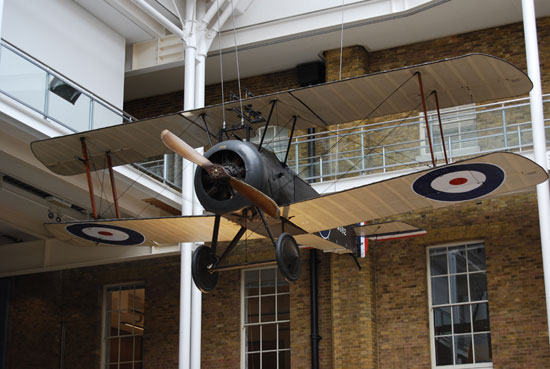When the “Guns of August” began firing 100 years ago, few expected it to be a long war, and fewer still expected it to be a “World War.” However, the “Great War,” as it was known to contemporaries, in fact, was destined to become the First World War — and it truly was the first modern war.
Today it is easy to look back at the Second World War for providing great technological advancements. It ushered in the atomic bomb, jet aircraft, and even Silly Putty; however, the First World War also was a war of great technological advances. Many of those efforts resulted in horrific casualties, which numbered in the tens of millions.
World War I began very much as a 19th-century war, with soldiers on both sides marching into battle in uniforms that wouldn’t have been out of place on parade grounds. Horses were used by cavalry and as a means of transport, and one of the greatest pre-war technological advancements was actually the railroad.
Germany worked feverishly for more than a decade to build up a railway network to transport men and materials quickly across the country. In fact, one reason the war became “unstoppable” in the summer of 1914 was that German troops were already in motion.
Modern Warfare
One of the tragedies of World War I was that its high casualties were due very much to the fact that the military leaders, who actually had not experienced a major conflict in Europe, simply did not comprehend the devastating power of modern weapons.
“Along with the transition from real horsepower, there’s also the dreadful toll that what might be called a “generational ignorance” of technology — by older, set-in-their-ways commanders who willfully refused to acknowledge the impact of new weaponry — took on men in the trenches,” said history buff Charles King, principal analyst at Pund-IT.
“There is strong historical evidence that there was a disconnect between the command line officers, who had been bred with 19th-century tactics, and the situation as it unfolded,” he told TechNewsWorld. “The commanders were simply not ready for the technical advancements faced by the front line soldiers.”
As soon as it began, it should have been clear to the commanders that this was going to be a different war — but as with the troop trains, it was impossible to change course.
“World War I started in the late summer of 1914 with a mix of Franco-Prussian War uniforms and tactics, but almost immediately caused some shifts to a modern war of aerial bombardment — total war with civilians being killed as well as mobilized on a grand scale,” said DoranCart, senior curator at the National World War I Museum in KansasCity.
“Posters urged everyone to join up, save food, support the war efforts by deed and thought,” he told TechNewsWorld. “Almost instant communications, improved railroads and ships, and the immediate use and continued development of airplanes did make it a truly modern war.”
The Fog of War
One fact that often is lost in the century of hindsight about World War I is that no one on either side actually expected a long or drawn-out conflict. Instead of making it a quick war, technological advances had the opposite effect.
WWI greatly accelerated “the advance of technologies — munitions, chemical weapons, radio, aircraft, etc. — that until that point was moving rather slowly,” Practical Futurist Michael Rogers told TechNewsWorld.”War has always been the major catalyst for technology.”
Even those with foresight were unable to see the horrors that the war was to unleash, he added.
“I love to point out that in H.G. Wells’1900 book Anticipations — which made a lot of remarkably accurate predictions about the 20th century — he totally missed on both the airplane and the submarines. He expected aircraft to become workable around the 1950s and averred that submarines would never, ever work, except to drown the captain and crew,” noted Rogers.
The Arms Race
As the armies bogged down in WWI’s now infamous trench warfare, military planners on both sides looked to break the stalemate. Their efforts ushered in advances in aircraft, ships, and armored vehicles.
“World War I, in technical terms, from the military point of view, was really a turning point,” said Capt. Dale Dye, USMC (Retired), a military history consultant for movies and TV.
“The war was simply pivotal in terms of technology. Tactical aviation came into its own, the tank had huge ramifications in tactics and strategy, and there were new and horrible ways to kill one another — including chemical warfare and other types of biological weapons,” he pointed out.
War became far more mechanized due to the fact that Europe had experienced a leap forward with the industrial revolution.
“We think of the trench warfare, but this was really the early development of highly mobile forces built around machines,” addedPund-IT’s King. “When the Allied forces — including the United States, France, and Great Britain — were able to use the mobile advantage, including the tank, it changed the outcome of a battle.”

Drive to the Front
The Allied victory also can be credited to the use of the automobile. As early as September 1914, when the war was just weeks old, the FrenchArmy raced to the front lines at the Battle of the Marne with the aid of Parisian taxis. Later in the war, trucks were used to move men and materials to the front, which provided greater mobility at faster speeds.
That, in turn, jump-started the post-war automobile industry, especially in the United States.
“Automobiles and trucks really didn’t advance new possibilities, but just the sheer number that was produced boded well for civilian availability, and use and the development of better road systems,” added National World War I Museum’s Cart.
“A great advance along these lines was the tracked vehicle motion developed from earlier agricultural applications for heavy ordnance movement and tanks would change farming as well as construction.”
“This is an example of swords into plowshares,” Dye told TechNewsWorld. “Motor transport had to deal with rough terrain, but the tank and tracked vehicles did lead to the machinery that helped build the modern cities of the interwar era.”
The technology also was crucial to then connecting the cities via air travel, which became possible thanks to the efforts to build bigger planes.
“Indeed, with the development of heavy bombers came the idea and the machinery for actually carrying passengers instead of bombs,” Cartnoted.
Saving Lives
It wasn’t just killing machines that came out of the war. World War I saw technological improvements to save lives — notably in the helmets and body armor that made a comeback in the trenches.
“These never really went away,” said Dye. “Armor was used from antiquity, but in World War I, the helmets and body armor were looked at in new ways — some of which are still in use today for the police and even in sports.”
Battlefield wounds less frequently were death sentences, as medical advances tried to keep pace with efforts to kill.
“Probably the most beneficial were the advances in medical technologies and treatments: new techniques of treating head traumas, development of the triage system for treating the wounded in an orderly fashion, creation of the Carrel-Dakin Solution for cleaning wounds, and great advances in what would be later called plastic surgery,” said Cart. “Also, having advanced medical treatment facilities closer to the action saved more lives.”
Some of the medical advances found post-war use in civilian products as well.
“Because of the sheer number of wounds, nurses and doctors had to find an alternative to the traditional handmade cloth bandage,” said King.”The French came up with a cellulose bandage, and it didn’t take long for the nurses to realize that those could be used as sanitary napkins as well.”
For those technological advances, humanity paid a huge price — not only the millions of deaths that occurred during WWI but also the scourge of continued conflict; the war shifted boundaries that remain a problem even to this day. The Great War was not to be the”war to end all wars” but rather a stark turning point in the history of the 20th century.
“To paraphrase American humorist Will Rogers,” said Cart, “the advances in weapons technology just proved that we could come up with better ways to kill each other.”
























































